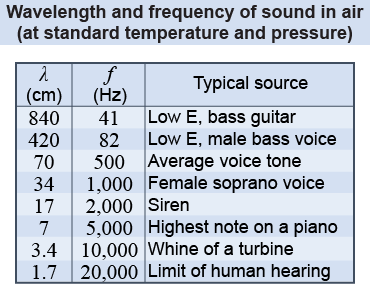|
The frequencies of sound that the average human ear can perceive range from a low of around 20 Hz to a high of around 20,000 Hz. Most of the information contained in the human voice, however, is limited to the range between about 100 and 2,000 Hz. The physical range of frequencies of sound is much greater than what humans can hear. Whales can sense sounds in water at frequencies below 10 Hz. Bats can sense sound frequencies in air higher than 100,000 Hz. 
 |
 Sound does not travel in space (a vacuum). There must be matter to have pressure, and without pressure, there cannot be a sound wave. The impressively loud explosions from space battles in science fiction movies are not realistic in terms of sound! If a space battle actually occurred and you were watching from your own, distant spaceship, you would hear total silence because there is no air in space to carry the sound waves.
Sound does not travel in space (a vacuum). There must be matter to have pressure, and without pressure, there cannot be a sound wave. The impressively loud explosions from space battles in science fiction movies are not realistic in terms of sound! If a space battle actually occurred and you were watching from your own, distant spaceship, you would hear total silence because there is no air in space to carry the sound waves. 
|

|
 Medical ultrasound technology uses sound waves at frequencies of 106 Hz and higher. These frequencies are inaudible to the ear but pass readily through living tissue. Differences in tissue density reflect ultrasound waves back to a detector and allow sophisticated imaging without harm to the patient. The figure on the right is an ultrasound image of a 22-week old baby still in the womb.
Medical ultrasound technology uses sound waves at frequencies of 106 Hz and higher. These frequencies are inaudible to the ear but pass readily through living tissue. Differences in tissue density reflect ultrasound waves back to a detector and allow sophisticated imaging without harm to the patient. The figure on the right is an ultrasound image of a 22-week old baby still in the womb. 
|
 The wavelength of sound in air is comparable to the size of everyday objects. For example, a 1,000 Hz sound wave in air has a wavelength of 34 cm, or about the length of your forearm. The wavelength of sound is important in many technologies, including musical instruments. To design a vibrating object to make a certain frequency of sound, the size of the object must be comparable to the corresponding wavelength of the sound. A trombone is a good example. Pulling in the slide on a trombone results in a shorter wavelength vibration and a higher frequency sound.
The wavelength of sound in air is comparable to the size of everyday objects. For example, a 1,000 Hz sound wave in air has a wavelength of 34 cm, or about the length of your forearm. The wavelength of sound is important in many technologies, including musical instruments. To design a vibrating object to make a certain frequency of sound, the size of the object must be comparable to the corresponding wavelength of the sound. A trombone is a good example. Pulling in the slide on a trombone results in a shorter wavelength vibration and a higher frequency sound. 
|
The wavelength of sound varies depending on the properties of the material through which the sound is traveling. A 1 kHz (1,000 Hz) sound in air at 20ºC and 1 atmosphere has a wavelength of 34 cm. A 1 kHz sound wave in water has a wavelength of 150 cm, almost five times longer than in air. In general, the more resistant to compression a medium is, the longer the wavelength for a given frequency of sound. Steel is even more resistant to being compressed than water and the wavelength of a 1 kHz sound in steel is 5 m! 
 |
The wavelength of sound in air depends on temperature and pressure. At 20ºC a 1 kHz sound has a wavelength of 34 cm. At 0ºC the wavelength drops to 33 cm. The reduction in wavelength with temperature occurs because air molecules move slower at lower temperature. This reduces the speed of sound. To keep frequency constant, the wavelength must decrease as the speed of the wave decreases. The effect of changing pressure is much smaller, typically 1% or less. 
|
Sound waves of a frequency of 172 Hz have a wavelength of 2 m in air. When these waves enter water, their wavelengths change to 8.7 m. What is the speed of sound in water? - 19.7 m/s
- 39.4 m/s
- 343 m/s
- 1,496 m/s
 |
The correct answer is d. 
|
Why are many representations of sound waves, such as the waveform graph, misleading?
 |
Depictions of sound waves typically show transverse waves, since making the oscillation appear perpendicular to the movement makes the wavelength easy to identify. In reality, sound is a longitudinal wave, which oscillates parallel to its movement. 
|

